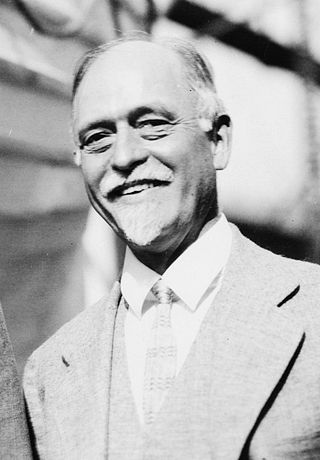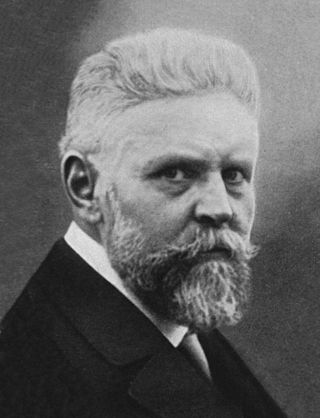Related Research Articles
Eugenics is a set of beliefs and practices that aim to improve the genetic quality of a human population. Historically, eugenicists have attempted to alter human gene pools by excluding people and groups judged to be inferior or promoting those judged to be superior. In recent years, the term has seen a revival in bioethical discussions on the usage of new technologies such as CRISPR and genetic screening, with heated debate around whether these technologies should be considered eugenics or not.
The Eugenics Board of North Carolina (EBNC) was a State Board of the U.S. state of North Carolina formed in July 1933 by the North Carolina State Legislature by the passage of House Bill 1013, entitled "An Act to Amend Chapter 34 of the Public Laws of 1929 of North Carolina Relating to the Sterilization of Persons Mentally Defective". This Bill formally repealed a 1929 law, which had been ruled as unconstitutional by the North Carolina Supreme Court earlier in the year.

Irving Fisher was an American economist, statistician, inventor, eugenicist and progressive social campaigner. He was one of the earliest American neoclassical economists, though his later work on debt deflation has been embraced by the post-Keynesian school. Joseph Schumpeter described him as "the greatest economist the United States has ever produced", an assessment later repeated by James Tobin and Milton Friedman.

The National Institute for Occupational Safety and Health is the United States federal agency responsible for conducting research and making recommendations for the prevention of work-related injury and illness. NIOSH is part of the Centers for Disease Control and Prevention (CDC) within the U.S. Department of Health and Human Services. Despite its name, it is not part of either the National Institutes of Health nor OSHA. Its current director is John Howard.

The term racial hygiene was used to describe an approach to eugenics in the early 20th century, which found its most extensive implementation in Nazi Germany. It was marked by efforts to avoid miscegenation, analogous to an animal breeder seeking purebred animals. This was often motivated by the belief in the existence of a racial hierarchy and the related fear that "lower races" would "contaminate" a "higher" one. As with most eugenicists at the time, racial hygienists believed that the lack of eugenics would lead to rapid social degeneration, the decline of civilization by the spread of inferior characteristics.

The social hygiene movement was an attempt by Progressive era reformers to control venereal disease, regulate prostitution and vice, and disseminate sexual education through the use of scientific research methods and modern media techniques. Social hygiene as a profession grew alongside social work and other public health movements of the era. Social hygienists emphasized sexual continence and strict self-discipline as a solution to societal ills, tracing prostitution, drug use and illegitimacy to rapid urbanization. The movement remained alive throughout much of the 20th century and found its way into American schools, where it was transmitted in the form of classroom films about menstruation, sexually transmitted disease, drug abuse and acceptable sexual behavior in addition to an array of pamphlets, posters, textbooks and films.
The Adelphi Genetics Forum is a non-profit learned society based in the United Kingdom. Its aims are "to promote the public understanding of human heredity and to facilitate informed debate about the ethical issues raised by advances in reproductive technology."

Ernst Rüdin was a Swiss-born German psychiatrist, geneticist, eugenicist and Nazi, rising to prominence under Emil Kraepelin and assuming the directorship at the German Institute for Psychiatric Research in Munich. While he has been credited as a pioneer of psychiatric inheritance studies, he also argued for, designed, justified and funded the mass sterilization and clinical killing of adults and children.

The New York City Department of Health and Mental Hygiene is the department of the government of New York City responsible for public health along with issuing birth certificates, dog licenses, and conducting restaurant inspection and enforcement. The New York City Board of Health is part of the department. Its regulations are compiled in title 24 of the New York City Rules. Since March 2022, the commissioner has been Ashwin Vasan.
Euthenics is the study of improvement of human functioning and well-being by improvement of living conditions. "Improvement" is conducted by altering external factors such as education and the controllable environments, including environmentalism, education regarding employment, home economics, sanitation, and housing, as well as the prevention and removal of contagious disease and parasites.
In 1928, the Legislative Assembly of Alberta, Canada, enacted the Sexual Sterilization Act. The Act, drafted to protect the gene pool, allowed for sterilization of mentally disabled people in order to prevent the transmission of traits to offspring deemed undesirable.

Nazi eugenics refers to the social policies of eugenics in Nazi Germany, composed of various ideas about genetics which are now considered pseudoscientific. The racial ideology of Nazism placed the biological improvement of the German people by selective breeding of "Nordic" or "Aryan" traits at its center. These policies were used to justify the involuntary sterilization and mass-murder of those deemed "undesirable".
Law for the Prevention of Genetically Diseased Offspring or "Sterilisation Law" was a statute in Nazi Germany enacted on July 14, 1933, which allowed the compulsory sterilisation of any citizen who in the opinion of a "Genetic Health Court" suffered from a list of alleged genetic disorders – many of which were not, in fact, genetic. The elaborate interpretive commentary on the law was written by three dominant figures in the racial hygiene movement: Ernst Rüdin, Arthur Gütt and the lawyer Falk Ruttke.
The following outline is provided as an overview of and topical guide to health:
Compulsory sterilization in Canada has a documented history in the provinces of Alberta, Saskatchewan, and British Columbia. In 2017, sixty indigenous women in Saskatchewan sued the provincial government, claiming they had been forced to accept sterilization before seeing their newborn babies.

Eugenics, the set of beliefs and practices which aims at improving the genetic quality of the human population, played a significant role in the history and culture of the United States from the late 19th century into the mid-20th century. The cause became increasingly promoted by intellectuals of the Progressive Era.

George Chandler Whipple was an American civil engineer and an expert in the field of sanitary microbiology. His career extended from 1889 to 1924 and he is best known as a co-founder of the Harvard School of Public Health. Whipple published some of the most important books in the early history of public health and applied microbiology.
The history of eugenics is the study of development and advocacy of ideas related to eugenics around the world. Early eugenic ideas were discussed in Ancient Greece and Rome. The height of the modern eugenics movement came in the late 19th and early 20th centuries.
Institutions for Defective Delinquents (IDDs) were created in the United States as a result of the eugenic criminology movement. The practices in these IDDs contain many traces of the eugenics that were first proposed by Sir Francis Galton in the late 1800s. Galton believed that "our understanding of the laws of heredity [could be used] to improve the stock of humankind." Galton eventually expanded on these ideas to suggest that individuals deemed inferior, those in prisons or asylums and those with hereditary diseases, would be discouraged from having children.

The Virginia Sterilization Act of 1924 was a U.S. state law in Virginia for the sterilization of institutionalized persons "afflicted with hereditary forms of insanity that are recurrent, idiocy, imbecility, feeble-mindedness or epilepsy”. It greatly influenced the development of eugenics in the twentieth century. The act was based on model legislation written by Harry H. Laughlin and challenged by a case that led to the United States Supreme Court decision of Buck v. Bell. The Supreme Court upheld the law as constitutional and it became a model law for sterilization laws in other states. Justice Holmes wrote that a patient may be sterilized "on complying with the very careful provisions by which the act protects the patients from possible abuse." Between 1924 and 1979, Virginia sterilized over 7,000 individuals under the act. The act was never declared unconstitutional; however, in 2001, the Virginia General Assembly passed a joint resolution apologizing for the misuse of "a respectable, 'scientific' veneer to cover activities of those who held blatantly racist views." In 2015, the Assembly agreed to compensate individuals sterilized under the act.
References
- ↑ "NATIONAL SOCIETY TO CONSERVE LIFE; Life Extension Institute Formed to Teach Hygiene and Prevention of Disease. LARGE CAPITAL BEHIND IT Ex-President Taft, Chairman; Prof. Irving Fisher, E.E. Rittenhouse, and Others Direct It". The New York Times . December 30, 1913.
- ↑ Fisher, Irving; Eugene Lyman Fisk (1916). How to Live, Rules for Healthful Living Based on Modern Science, Authorized by and Prepared in Collaboration with the Hygiene Reference Board of the Life Extension Institute, Inc (8th ed.). New York; London: Funk & Wagnalls Company. ISBN 978-1-59605-035-8. OCLC 146204564.
